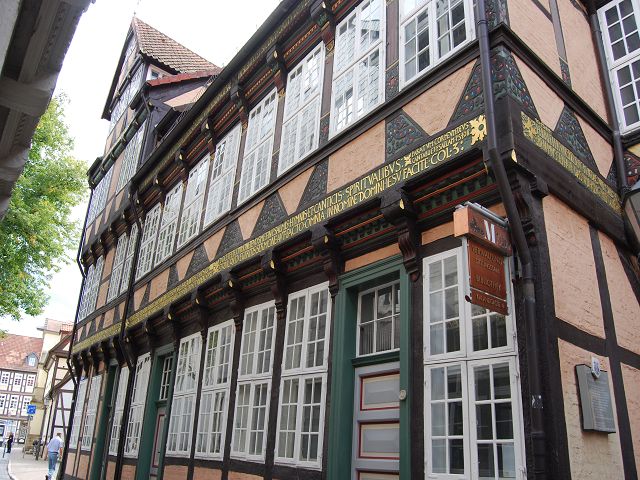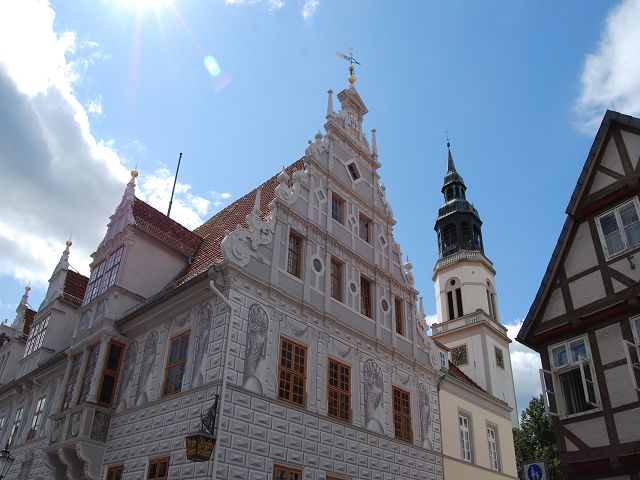A brief history of Celle
Cellensia - Celle - Celler Land - Residenzstadt Celle
A brief history of Celle
Celle was first mentioned in a document of A.D. 985 as Kiellu ( Fischbucht ) or fishing bay.
It was granted the right to mint and circulate its own coins ( Münzrecht ) [minting privileges]) during the 11th century and several coins were found in the Sandur hoard in the Faroes.
In 1292 Duke Otto II the Strict ( 1277-1330 ), a Guelph who ruled the Principality of Lüneburg from 1277 to 1330 left Altencelle, where there had been a defences in the form of a circular rampart (the Ringwall von Burg) since the 10th century, and founded a rectangular settlement by the existing castle (Burg) 4 kilometres (2.5 mi) to the northwest. In 1301 he granted Celle its town privileges, and in 1308 started construction on the town church.
In 1378 Celle became the Residenz of the dukes of Saxe-Wittenberg and, in 1433, the princes of Lüneburg took up residence in the castle (Schloss). The ducal palace was situated on a triangle between the River Aller and its tributary, the Fuhse. A moat connecting the rivers was built in 1433, turning the town centre into an island. In 1452 Duke Frederick the Pious of Lüneburg founded a Franciscan monastery. In 1464 the grain shipping monopoly generated an economic upturn for the town.
The early modern period in Celle
In 1524 the Reformation was introduced into Celle.
In 1570 Duke William the Younger built the castle chapel which was consecrated in 1585.
From 1665 to 1705 Celle experienced a cultural boom as a Residenz under Duke George William.
This has been particularly put down to his French wife, Eleonore d'Olbreuse, who brought fellow Huguenot Christians and Italian architects to Celle. During this time the French and Italian Gardens were laid out and the baroque castle theatre built.
In 1705 the last duke of the Brunswick-Lüneburg line died and Celle, along with the Principality of Lüneburg, passed back to the Hanover line of the Guelphs.
By way of compensation for the loss of its status as a Residenz town numerous administrative institutions were established in Celle, such as the Higher Court of Appeal , the prison and the State Stud Farm.
That began its development into an administrative and judicial centre.
Even today the Lower Saxony-Bremen State Social Security Tribunal and
the High Court responsible for most of Lower Saxony are based in Celle,
amongst others
In August 1714, George Elector of Hanover, Duke of Brunswick-Lüneburg ( King George I ) who was married to the daughter of Duke Georg Wilhelm - princess Sophie Dorothea, the "Princess of Ahlden" (see extra page) - ascended to the British throne.
Between then and 1866, when the town became Prussian during the Austro-Prussian War as part of the province of Hanover, Celle was a possession of the British Hanoverian line.
In 1786 Albrecht Thaer founded the first German Agricultural Testing Institute in the meadows at Dammasch (today Thaer's Garden). The Albrecht-Thaer School is nowadays part of a vocational centre in the Celle sub-district of Altenhagen.
The modern period in Celle
In 1892 − with the help of numerous citizens' donations − the present-day Bomann Museum with its important folkloric and town history collections was founded. In 1913 the 74 metre high clock tower was built on the town church, its clockwork underwent a major restoration in 2008.
In September 1929 Rudolph Karstadt opened a Karstadt department store in Celle town centre, the façade of which was identical with that of the Karstadt store on Berlin's
Hermannplatz


Celle
is a town and capital of the district of Celle, in Lower Saxony, Germany. The town is situated on the banks of the River Aller, a tributary of the Weser and has a population of about 71,000.
Celle is the southern gateway to the Lüneburg Heath, has a castle (Schloss Celle) built in the renaissance and baroque style and a picturesque old town centre (the Altstadt) with over 400 timber-framed houses, making Celle one of the most remarkable members of the German Timber-Frame Road.
From 1378 to 1705, Celle was the official residence of the Lüneburg branch of the dukes of Brunswick-Lüneburg ( House of Guelph ) who had been banished from their original ducal seat by its townsfolk.
